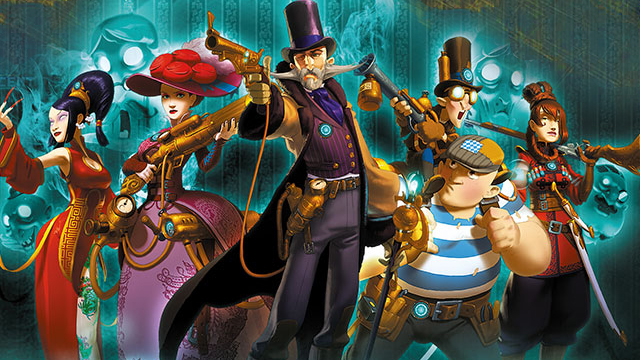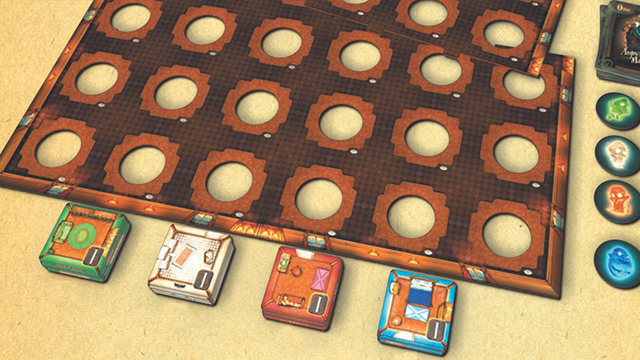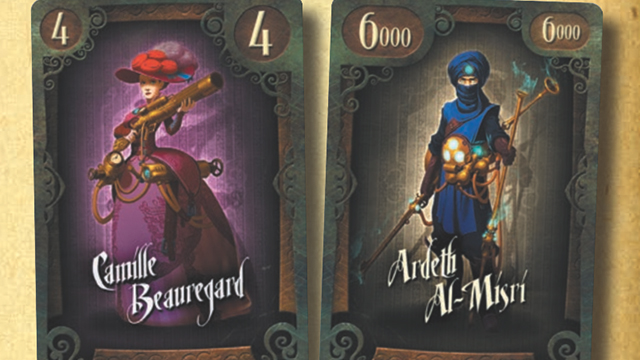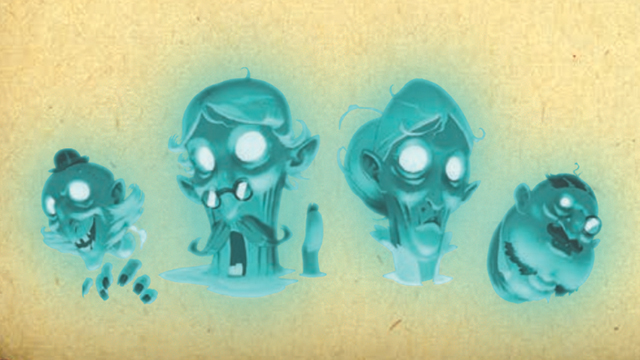
Ghostbusters was a landmark in the pop culture development of my generation, and it still resonates today. News of an all-female cast version of the movie sent shockwaves through the internet, and a Cryptozoic Kickstarter campaign for an official board game crushed its $250,000 goal. As much as I love Ghostbusters, I did not back that campaign, mostly due to the fact that I had already played 2013 Iello Games release The Phantom Society and didn’t see the need.
In The Phantom Society, one player (or team) represents four malevolent spirits haunting the Sir Phillipp Venkman Malombier Manor Hotel (no relation, I’m sure), while the other represents the eponymous Phantom Society hired to capture them. The trick, much like the famous “Slimer” hotel scene in Ghostbusters, is doing so while not utterly destroying the hotel in the process.
To begin, first players place the rooms into the six-by-six hotel grid. Each player has one or two colors of rooms, and placement alternates between ghost players and society players. Once that is complete, the ghost player (or team) hides each ghost in secret under one of the rooms that matches the ghost’s respective color. Remembering where the ghosts are hidden is important, and taking notes might be helpful.

On the ghosts’ turn, one of the still-hidden ghosts can destroy a room adjacent (including diagonally) to its hiding place, adding its value to the running total. The Society team thus knows that at least one ghost must be hidden in one of the eight rooms adjacent to the destroyed one, and the game is truly afoot. On the Society’s turn, they destroy any one room. If a ghost is hiding there, there is no penalty. If there is no ghost in that room, however, the room’s value is added to the ghosts’ score! Turns alternate between the two sides until either all four ghosts are found or the required value of damage has been inflicted.
Regardless of who destroyed it, a destroyed room is skipped over when determining adjacency. This allows the ghosts to reach beyond their starting options as the game progresses. It also illustrates why the initial placement of the rooms is so important. Ghost players want high-value rooms in the middle of the board for easier access, while Society players want those rooms on the edges (or even better, corners) to better protect them.
The rest of the gameplay comes down to strategy and deduction. Every room destroyed by the ghosts each turn gives away precious information. No matter how tempting that six-point room in the corner might be, destroying it too early will give away far too much about a ghost’s location as there are fewer adjacent rooms. Another cunning, if double-edged, ghost strategy can be to hide ghosts under those very same high-value rooms. The ghosts won’t be able to score those valuable rooms, but the Society is probably going to be quite reluctant to look there without very good reason which could buy the ghosts precious time to make up the difference.

Misdirection and teamwork are also factors working in the ghosts’ favor. Suppose two adjacent rooms are destroyed by ghosts. Is a ghost hiding in one of the few mutually-adjacent rooms, or is it located at the end of the line? What if this destruction was caused by two separate ghosts and one of them is found? How long does the other one get a free ride until the Society catches on?
Which is not to say that the Society is completely helpless in their quest. Once they capture one ghost, they know they no longer have to investigate any rooms of that color, which can eliminate a substantial amount of the remaining board from consideration. Getting to that point will probably require a fair bit of luck (or ghost carelessness), but paying attention to which rooms are destroyed will eventually let logic win the day. If there are more than two players, each member of the ghost team only gets to control two of the ghosts so the destruction potentially gives away more information as the players alternate turns.
Normally the amount of damage necessary to end the game is fixed, with a two-player game having a slightly higher target than that of team play. Optional rules allow for players to bid on that target using specially-designed cards. Each team gets an identical set of three cards depicting tens of thousands of pounds, plus one unique set representing thousands. To prevent ties, one team only gets even-valued thousands and the other team gets the odd-valued cards. Whichever team bids the highest gets to play as the ghosts — with the losing team’s lower bid being used as the target value! Choose wisely!

To be fair, The Phantom Society lacks the characterization and humor that I’m sure will be part of the official Ghostbusters game. From a pure gameplay perspective, though, I have a hard time believing that the elegant logical play of The Phantom Society will be matched by a minis-based “action” game. Sometimes less is more, especially when it comes to board games.
The Phantom Society plays in about 20 minutes, as the constant destruction of rooms doubles as a timer thanks to the ghosts’ win condition. There is also no reading required, making it ideal for younger players; the designers recommend ages eight and up. It has an MSRP of $40.



















